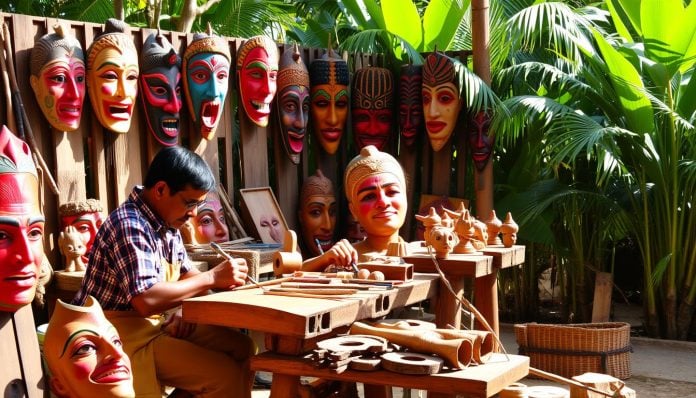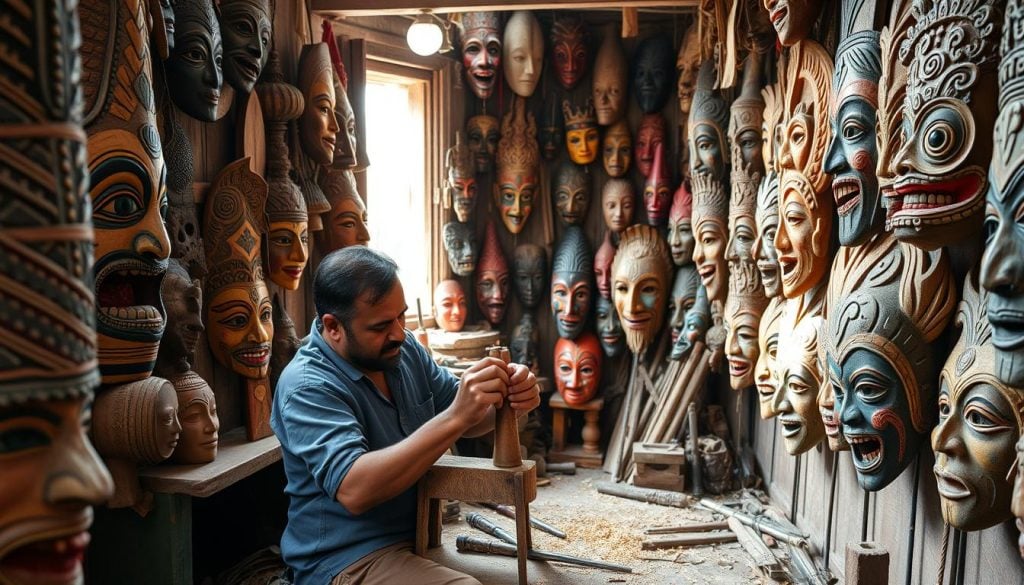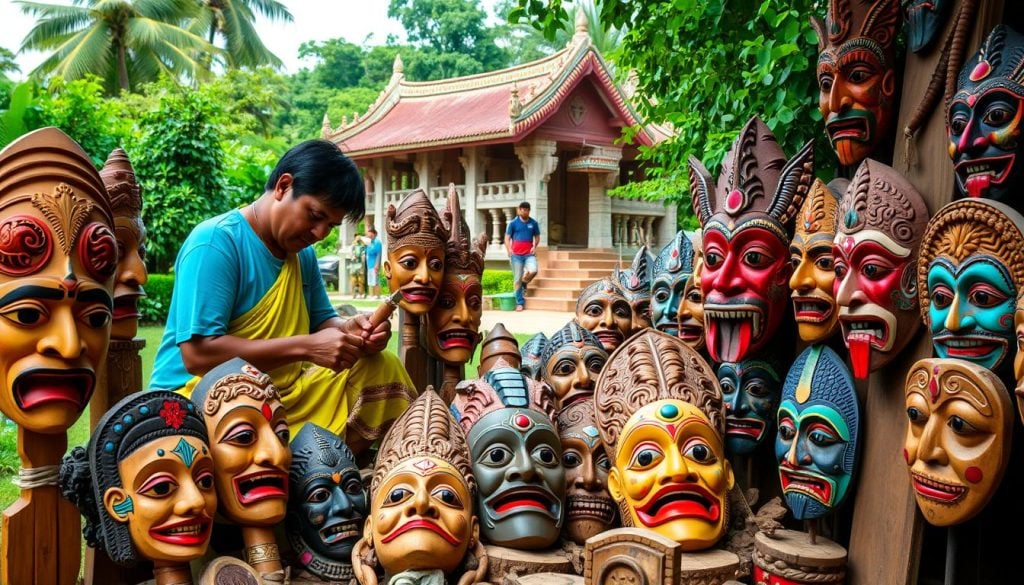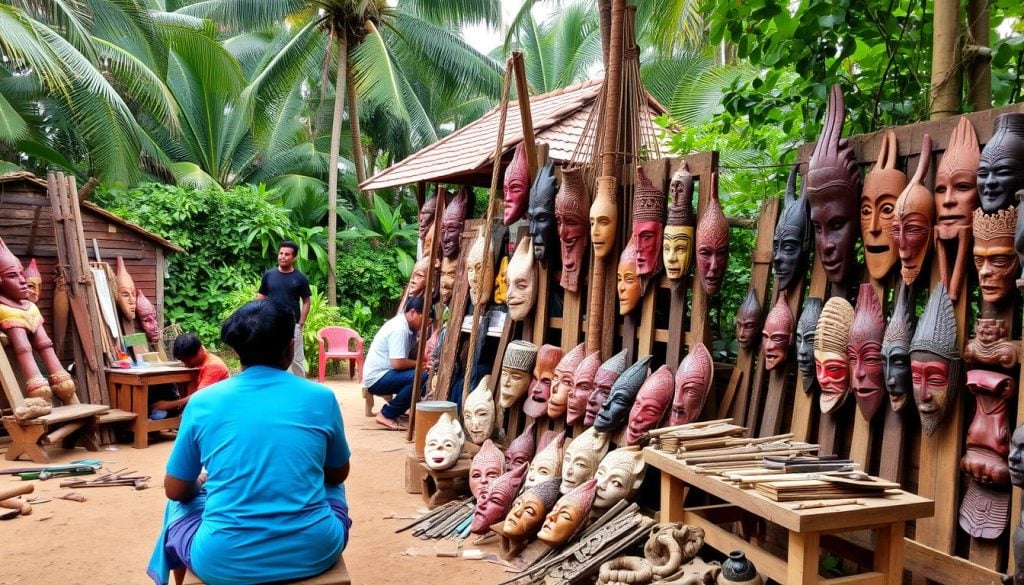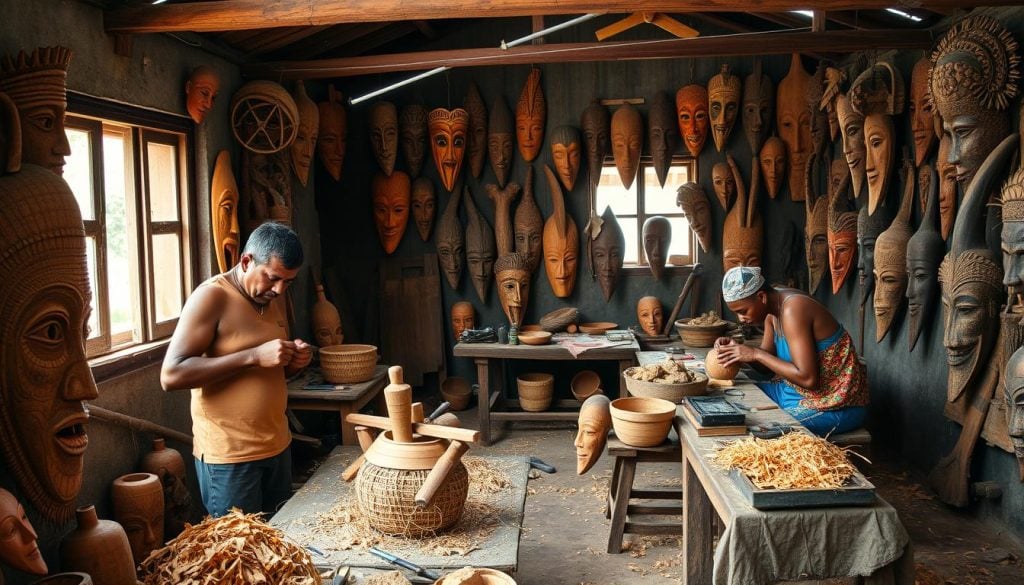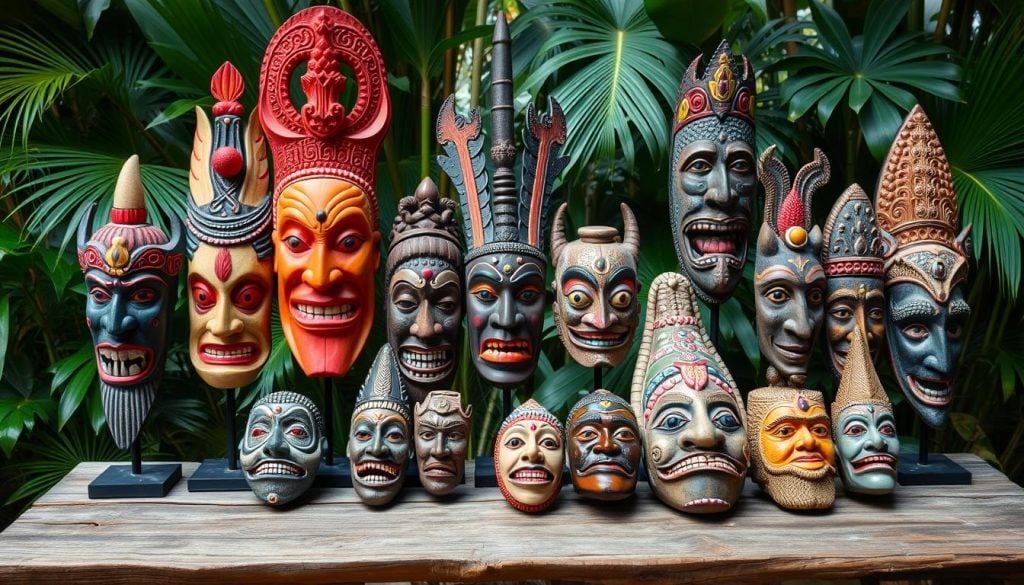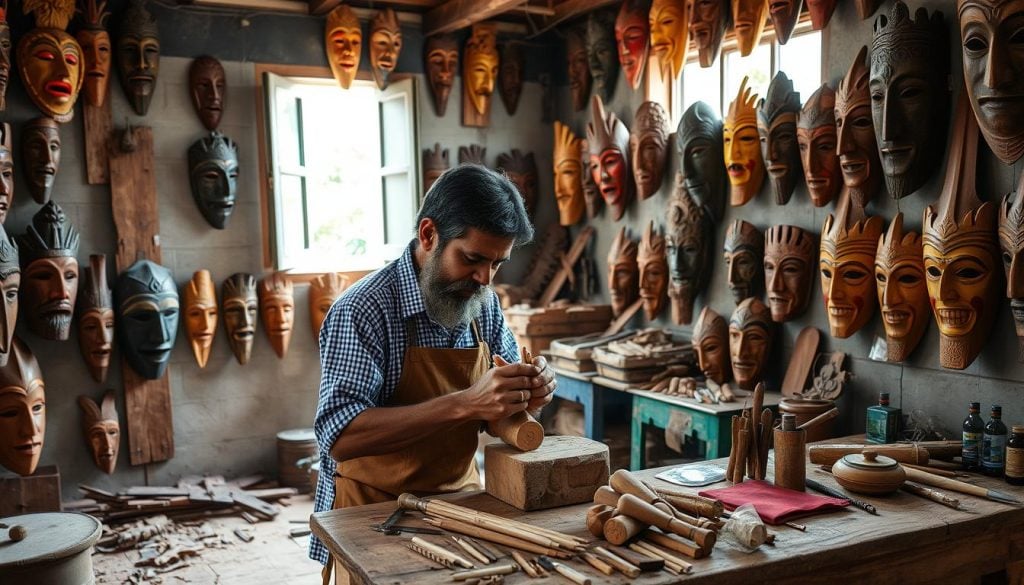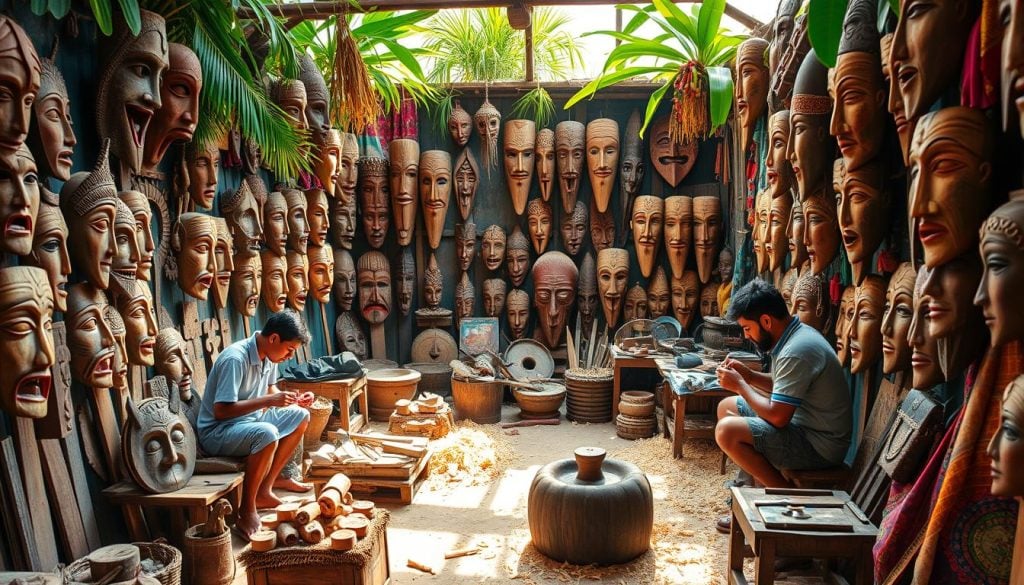Ever wondered about the stories behind Sri Lanka’s colorful masks? Galle’s mask carving demos let you see these tales through the hands of talented artists. You’ll discover the importance of these masks and how they show Sri Lanka’s deep heritage.
Experience authentic mask carving in Galle. Here, the old and new blend in a vibrant display of creativity.
Introduction to Traditional Mask Carving in Sri Lanka
Sri Lankan mask carving has a long history, deeply connected to the country’s art and culture. It started in rituals and stories, giving us a peek into local beliefs. Each mask has its own story, often tied to myths and legends.
The craft uses natural materials like wood and plant-based paints. Artists use techniques passed down through generations, showing their skill and hard work. These masks are not just beautiful; they hold deep cultural meaning in Sri Lanka.
These masks are more than decorations; they play key roles in dances and rituals. They represent characters like gods and ancestors, helping tell stories through movement. Exploring Sri Lankan handicrafts like mask carving opens a window into the country’s rich cultural heritage, where art and tradition blend beautifully.
Significance of Masks in Sri Lankan Culture
Masks in Sri Lanka hold deep cultural meaning. They tell stories and keep traditions alive. These masks are used in ceremonies and festivals, playing a big role in community life.
In dances like the Kolam and Devil Dance, masks bring characters from local tales and faith to life. They show us what Sri Lankan society believes in. Each mask has its own tale, letting performers connect with the audience through shared stories.
Learning about mask carving shows us the artistry behind these symbols. Masks are key in many rituals, showing the lively spirit of Sri Lankan culture. They show how art and stories blend with tradition.
Exploring Galle’s Cultural Heritage
Galle is a treasure trove of history, blending Sinhalese and Portuguese cultures. Its architecture and stunning coastlines draw many who seek cultural experiences. The UNESCO World Heritage site of Galle Fort is a must-see, with its preserved colonial buildings telling stories of the past.
Walking through the fort, you find streets filled with local art. This art shows the community’s spirit and traditions. It’s a chance to dive into Sri Lankan culture. Galle’s mix of old and new makes it a special place for history and art lovers.
Getting to know the local culture opens doors to understanding traditions like mask carving. It shows how important this art is to Galle’s community. These experiences help you connect with Galle’s lively spirit.
Traditional Mask Carving Demonstrations in Galle
In Galle, you can dive into the world of traditional mask carving in Sri Lanka. These demonstrations let you see the amazing skills of local artists. You get to learn about this lively cultural art form up close.
Experience the Art Form First-Hand
Joining a Galle mask carving workshop deepens your understanding of the art. Watching skilled artisans work, you’ll see how they turn raw wood into beautiful masks. This hands-on setting lets you ask questions and learn more about the tradition.
What to Expect During Demonstrations
At these demonstrations, you’ll learn about the tools, the masks’ cultural value, and different carving styles. You’ll see a live carving session, where artisans show their skill. Many visitors leave with a new appreciation for this ancient practice and the artistry behind Sri Lanka’s masks.
Galle Mask Carving Workshops for Tourists
Visiting Galle offers a chance to dive into mask carving workshops. These workshops are run by local artisans for tourists. You’ll learn about mask carving and its cultural importance.
How to Participate in a Workshop
To join a workshop, book a session with local craftsmen or cultural centers. It’s easy to sign up, and the cost includes materials and instruction. Workshops are available all year, for all skill levels, making it fun for everyone.
Benefits of Hands-On Experience
Workshops let you learn new skills and appreciate Sri Lanka’s art. You’ll make your own mask with expert guidance. This hands-on learning makes you feel proud of your creation.
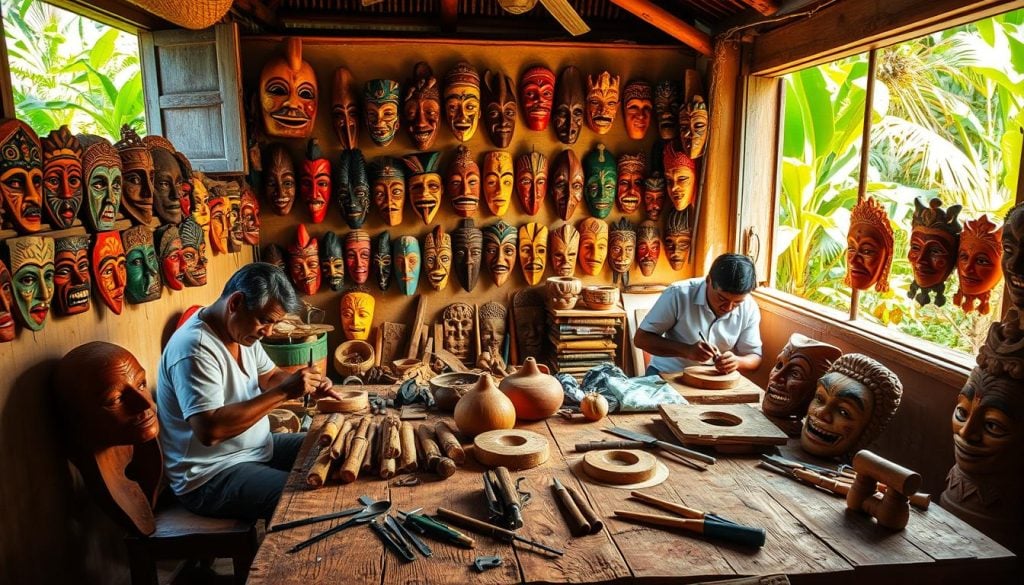
Meet Galle’s Mask Carving Artisans
In the heart of Galle, you’ll find dedicated mask carving artisans. Their work shows the true spirit of authentic mask carving in Galle. These artists come from families with a long history of carving, keeping old techniques alive.
Each artisan has a story that shows their love and hard work. Their days are filled with the sounds of chiseling wood and creativity. Here are some key points about their dedication:
- Expert Techniques: They use traditional tools and methods to make each mask, focusing on every detail.
- Family Heritage: Many learn from their parents or grandparents, keeping the tradition going.
- Modern Challenges: They face issues like less interest from young people and economic struggles, trying to keep their craft alive.
Talking to these skilled artisans lets you connect with their work and Galle’s mask carving heritage. It gives you a glimpse into the cultural importance and creativity in each piece they make.
History of Sri Lankan Mask Carving
The history of mask carving in Sri Lanka is a fascinating story. It shows how Sri Lankan culture and society have changed over time. Masks were first used in ancient times for religious and medical rituals. They were not just art but also played key roles in healing and spiritual events.
As time went on, masks started to change. The art of traditional Sri Lankan handicrafts became more popular. Artisans could show off their skills and create masks for theater. These masks told stories of local legends, bringing tales to life with color and movement.
Throughout history, different dynasties have left their mark on mask carving. Each period brought new styles and techniques, thanks to foreign influences. Trade and colonial times introduced new ideas and materials, making local crafts even more special.
- Initially tied to religious and healing practices.
- Evolution into theatrical representations and folklore.
- Influence of foreign cultures during colonial periods.
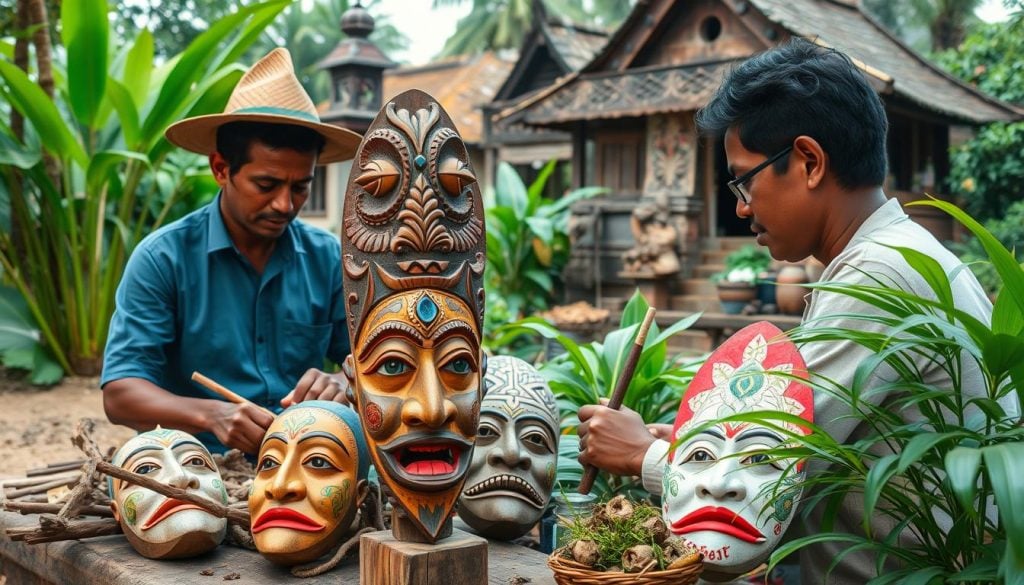
Looking into the history of mask carving in Sri Lanka reveals a deep bond between art and culture. Masks are more than just objects; they are windows into the past. They show how society and art have grown over time. Exploring this craft gives us a deeper understanding of Sri Lanka’s rich heritage.
| Period | Characteristics | Influences |
|---|---|---|
| Ancient Times | Religious and Healing Masks | Indigenous Beliefs |
| Colonial Era | Theatrical and Folklore Masks | European Influence |
| Modern Era | Artistic Innovation | Globalization and Cultural Exchange |
Types of Masks and Their Uses
Sri Lanka is home to a wide variety of masks. Each mask shows the rich culture of the country. Masks are more than just decorations; they carry deep meanings in rituals and performances. They play a big role in telling community stories and beliefs.
Cultural and Ritualistic Significance
Masks in Sri Lanka have a deep cultural meaning. The “Raksha” mask is key in exorcism rituals, fighting off evil spirits. “Kolam” masks are used in dances to share stories and feelings. This shows masks are vital in both spiritual and artistic areas.
Variations by Region
Masks vary across the island, showing regional differences. Each area has its own mask styles, shaped by local traditions and materials. For instance, coastal masks might have sea themes, while highland masks tell local tales. Understanding these differences helps us see the craft’s deep roots in the community.
| Type of Mask | Purpose | Region |
|---|---|---|
| Raksha | Exorcism rituals | Southern Sri Lanka |
| Kolam | Dance performances | Western Sri Lanka |
| Devil Masks | Cultural symbolism in rituals | Various regions |
| Nature Masks | Celebration of local folklore | Central Highlands |
| Animal Masks | Storytelling and entertainment | Southern and Western Sri Lanka |
Authentic Mask Carving in Galle
In Galle, authentic mask carving shows off a rich cultural heritage. Artisans here are committed to keeping traditional methods alive. They make masks that carry deep historical meaning.
These masks are made with old techniques and natural materials. This makes them more than just decorations. They hold cultural value.
Exploring mask-carving workshops, you see the masks’ true value. Each artisan adds their own special touch. This mix of old and new makes the masks both beautiful and accessible.
Working with local artisans helps keep their art alive. Supporting authentic mask carving in Galle means these traditions will last. The masks tell stories from Sri Lanka’s past, making them cultural treasures.
Galle Cultural Experiences: Combining Art and Tradition
When you visit Galle, you can dive into a wealth of Galle cultural experiences. These experiences beautifully intertwine art and tradition. The area offers a variety of activities that provide insight into local customs and heritage. These activities include:
- Traditional Dance Performances: Experience the rhythm and grace of local dancers dressed in vibrant attire, showcasing tales through movement.
- Local Festivals: Attend festivities that celebrate Galle’s rich heritage, filled with colors, music, and community spirit.
- Cooking Classes: Learn to prepare authentic Sri Lankan dishes, gaining a hands-on understanding of the local cuisine.
Engaging in these Galle heritage activities will enhance your overall visit. It provides a comprehensive understanding of Galle’s broader cultural landscape. Each experience offers a unique perspective that complements the traditional mask carving demonstrations. This makes your time in Galle both enriching and memorable.
Galle Heritage Activities Beyond Mask Carving
Mask carving is just the start in Galle. The city is full of Galle heritage activities that let you dive deeper into its culture. These activities help you understand the history and traditions that make Galle special.
Don’t miss the Galle Fort, a UNESCO World Heritage site. It shows the city’s colonial past and maritime trade. Walking its streets, you’ll see Dutch architecture and boutiques. Every corner has a story to tell.
Galle’s art scene is also worth exploring. Local galleries showcase both traditional and modern art. You can even join workshops to meet artists and learn about their work.
Here’s a table that highlights some top heritage spots in Galle:
| Attraction | Description | Significance |
|---|---|---|
| Galle Fort | A UNESCO World Heritage site with colonial architecture and historical significance. | Symbol of Galle’s rich maritime history and cultural blend. |
| National Maritime Museum | An exhibition of maritime artifacts showcasing Galle’s coastal heritage. | Highlights the importance of the sea in the region’s history. |
| Historical Churches | Stunning examples of colonial-era architecture, including Dutch Reformed Church and All Saints’ Church. | Offers insight into Galle’s religious and cultural evolution. |
| Local Art Galleries | Showcase contemporary and traditional artworks from local artists. | Supports local artisans and preserves the artistic legacy. |
These Galle heritage activities make your visit more than just mask carving. You’ll uncover a rich history and vibrant arts. It’s a chance to see a unique cultural tapestry up close.
Conclusion
Traditional mask carving in Galle gives you a special look into Sri Lanka’s rich culture. It’s more than just making beautiful masks. It’s a deep connection to local customs, stories, and rituals that show who they are.
Seeing mask carving in Galle lets you see the talent of local artists. Their work comes from years of tradition. You’ll learn about the masks’ history and the culture they represent.
Your trip to Galle will leave you with unforgettable memories. Exploring mask carving connects you to traditions that are still alive today. It shows a culture that is both changing and deeply rooted in history.

































